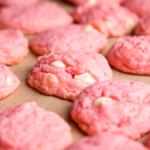Valentine’s Day is the perfect time to spread love and sweetness, and what better way to do so than with homemade cookies? These heart-shaped treats are not only delightful to look at but also deliciously soft and buttery. Whether you’re baking them for your significant other, family, or friends, these Valentine’s Day cookies are sure to warm hearts and bring smiles.
- Ingredients
- Tips
- How to make Valentine’s Day Cookies
- Assembling Valentine’s Day Cookies
- Decorations
- Troubleshooting
- Flavour Variations
- Pairing and serving suggestions
- FAQ
Ingredients
- All-Purpose Flour: Provides the base structure for the cookies. It contains gluten, which helps the cookies hold their shape and gives them a chewy texture.
- Baking Powder: Acts as a leavening agent, causing the cookies to rise and become light and fluffy as they bake.
- Salt: Enhances the flavor of the cookies and balances the sweetness. It also helps to strengthen the gluten in the flour, resulting in a better texture.
- Unsalted Butter: Adds richness and flavor to the cookies. The fat in the butter helps to tenderize the dough and create a soft and buttery texture.
- Granulated Sugar: Sweetens the cookies and helps to create a light and crisp texture. It also aids in spreading and browning during baking.
- Egg: Acts as a binder, helping to hold the dough together and provide structure to the cookies. It also adds moisture and richness to the dough.
- Vanilla Extract: Enhances the flavor of the cookies with its warm and aromatic notes. It adds depth and complexity to the overall taste of the cookies.
- Red or Pink Food Coloring: Optional ingredient used to tint the dough and give the cookies a festive Valentine’s Day color. It adds visual appeal and can be adjusted to achieve the desired shade of pink or red.
- Powdered Sugar (for Dusting): Optional ingredient used for dusting the cookies after baking. It adds a sweet and decorative finish to the cookies.
- Sprinkles or Colored Sugar (for Decoration): Optional ingredients used to decorate the cookies and add visual interest. They can be customized to match the theme or occasion.
Tips
- Make sure your butter is softened but not melted for the best texture in the cookies.
- If you prefer a softer cookie, slightly underbake them and let them cool completely on the baking sheet before transferring to a wire rack.
- Feel free to get creative with the decorations! You can use royal icing, melted chocolate, or any other toppings you prefer.
- Store the cookies in an airtight container at room temperature for up to one week, or freeze them for longer storage.
How to make Valentine’s Day Cookies
- Preheat the Oven: Preheat your oven to 350°F (175°C) and line baking sheets with parchment paper or silicone baking mats.
- Mix Dry Ingredients: In a medium-sized bowl, whisk together the flour, baking powder, and salt until well combined. Set aside.
- Cream Butter and Sugar: In a large bowl or the bowl of a stand mixer, cream together the softened butter and granulated sugar until light and fluffy, about 2-3 minutes.
- Add Egg and Vanilla: Beat in the egg and vanilla extract until well combined. If using food coloring, add a few drops to the mixture and beat until evenly distributed.
- Incorporate Dry Ingredients: Gradually add the dry ingredients to the wet ingredients, mixing on low speed until the dough comes together. Be careful not to overmix.
- Chill the Dough: Form the dough into a ball and flatten it into a disk. Wrap it in plastic wrap and refrigerate for at least 1 hour, or until firm.
- Roll Out the Dough: On a lightly floured surface, roll out the chilled dough to about 1/4 inch thickness. Use a heart-shaped cookie cutter to cut out cookies and place them on the prepared baking sheets, spacing them about 1 inch apart.
- Bake the Cookies: Bake in the preheated oven for 8-10 minutes, or until the edges are lightly golden brown. Remove from the oven and let the cookies cool on the baking sheets for 5 minutes before transferring them to a wire rack to cool completely.
- Sift the powdered sugar: In a large mixing bowl, sift the powdered sugar to remove any lumps. This will help ensure a smooth and creamy icing.
- Add meringue powder: Add the meringue powder to the powdered sugar and whisk together until well combined. Meringue powder acts as a stabilizer for the royal icing and helps it to set.
- Add warm water: Gradually add the warm water to the powdered sugar mixture, one tablespoon at a time, while mixing with a hand mixer or stand mixer fitted with a paddle attachment. Start with 4 tablespoons of water and add more as needed to reach your desired consistency.
- Mix until smooth: Continue mixing the icing until it becomes smooth and glossy. You want the icing to have a thick, but still fluid consistency. It should hold its shape when piped, but also slowly settle back into itself.
- Add vanilla extract: If desired, add vanilla extract to the icing for flavor. This is optional but adds a nice touch of flavor to the icing.
- Adjust consistency: If the icing is too thick, add a little more water, a teaspoon at a time, until it reaches the desired consistency. If it’s too thin, add more powdered sugar, a tablespoon at a time, until it thickens.
- Color the icing: Divide the icing into separate bowls if you want to use different colors. Add gel food coloring to each bowl and mix until the desired color is achieved.
- Cover the icing: To prevent the icing from drying out, cover the bowls with a damp towel or plastic wrap while you’re not using them.
- Decorate your cookies: Once your cookies are baked and cooled, use the royal icing to pipe designs, outlines, or flood the cookies with color. Allow the icing to dry completely before stacking or packaging the cookies.
- Store leftover icing: If you have leftover icing, store it in an airtight container at room temperature for up to several days. Stir or re-whip the icing before using it again.
Assembling Valentine’s Day Cookies
- Roll Out the Dough: On a lightly floured surface, roll out the cookie dough to your desired thickness. Aim for about 1/4 inch thickness for soft and chewy cookies, or slightly thinner for crisper cookies.
- Cut Out Shapes: Use heart-shaped cookie cutters to cut out the cookies from the rolled-out dough. Press the cutter firmly into the dough and lift it up carefully to avoid distorting the shape.
- Transfer to Baking Sheet: Carefully transfer the cut-out cookies onto parchment paper-lined baking sheets, spacing them about 1 inch apart. Use a spatula if necessary to lift the cookies without misshaping them.
- Re-roll and Repeat: Gather the dough scraps and gently re-roll them to cut out more cookies. Repeat the process until you’ve used up all the dough.
- Decorate: Once all the cookies are cut out and placed on the baking sheets, it’s time to decorate! Use sprinkles, colored sugar, or royal icing to add festive designs and decorations to your cookies.
Decorations
- Prepare Your Decorating Station: Set up a clean and organized workspace with all your decorating supplies handy. This includes icing, piping bags or squeeze bottles, sprinkles, edible glitter, and any other decorations you plan to use.
- Prepare Your Icing: If you’re using royal icing or any other type of icing that needs to be prepared, mix it according to the recipe instructions. Divide the icing into separate bowls if you plan to use different colors.
- Color Your Icing: Add gel food coloring to the icing to achieve your desired shades of pink, red, or any other Valentine’s Day colors you like. Mix the coloring thoroughly until the icing is evenly colored.
- Fill Piping Bags or Squeeze Bottles: Transfer the colored icing to piping bags or squeeze bottles, one for each color. If using piping bags, twist the top of the bag to prevent icing from leaking out.
- Outline the Cookies: Start by outlining the edges of each cookie with the icing. Use a steady hand and gentle pressure to create clean and even lines. Allow the outlines to set for a few minutes before flooding the cookies with icing.
- Flood the Cookies: Once the outlines have set, use a thinner consistency of icing (if necessary) to flood the inside of the outlines. Fill in the center of each cookie with icing, using a toothpick or offset spatula to spread it evenly and to the edges.
- Add Details: While the flooded icing is still wet, you can add additional decorations and details to your cookies. Use different colors of icing to create hearts, swirls, dots, or any other designs you like. You can also add sprinkles or edible glitter for extra sparkle.
- Let the Icing Set: Allow the decorated cookies to dry completely before handling or packaging them. This can take several hours, depending on the thickness of the icing and the humidity of your environment.
- Store or Package: Once the icing has fully set, you can store the decorated cookies in an airtight container at room temperature for up to several days. If you’re packaging them as gifts, place them in cellophane bags or decorative boxes tied with ribbon for a festive presentation.
Troubleshooting
- Dough Too Sticky or Dry:
- If the dough is too sticky, add a little more flour, a tablespoon at a time, until it reaches the right consistency.
- If the dough is too dry and crumbly, add a small amount of milk or water, a teaspoon at a time, until it comes together.
- Cookies Spreading Too Much:
- Ensure the dough is properly chilled before baking. If the dough is too warm, the cookies may spread excessively.
- Try placing the shaped cookies in the refrigerator for 10-15 minutes before baking to firm up the dough.
- Cookies Not Baking Evenly:
- Make sure your oven is properly preheated to the correct temperature.
- Rotate the baking sheets halfway through the baking time to ensure even baking.
- If some cookies are browning too quickly while others are undercooked, consider adjusting the placement of the baking sheets in the oven or reducing the temperature slightly.
- Cookies Too Crisp or Hard:
- Be cautious not to overbake the cookies. They should be just set and lightly golden around the edges when done.
- If the cookies become too hard after cooling, store them in an airtight container with a slice of bread or a damp paper towel to help soften them.
Flavour Variations
- Lemon Cookies: Add lemon zest and a splash of lemon juice to the cookie dough for a bright and refreshing flavor. You can also drizzle lemon glaze over the cooled cookies for an extra burst of citrus flavor.
- Almond Cookies: Add almond extract and chopped almonds to the cookie dough for a nutty and fragrant flavor. You can also top the cookies with sliced almonds before baking for added crunch.
- Coconut Cookies: Add shredded coconut to the cookie dough for a tropical twist. You can also dip the cooled cookies in melted chocolate and sprinkle with more shredded coconut for an extra decadent treat.
- Red Velvet Cookies: Add cocoa powder and a touch of red food coloring to the cookie dough for that classic red velvet flavor. You can also top the cookies with cream cheese frosting for an authentic red velvet experience.
Pairing and serving suggestions
- Serve with Hot Beverages: Pair your Valentine’s Day cookies with hot beverages such as coffee, hot chocolate, or tea. The warmth of the drinks complements the sweetness of the cookies, creating a cozy and comforting experience.
- Gift in Pretty Packaging: Package your cookies in decorative boxes, bags, or jars tied with ribbons or twine for a thoughtful and personalized gift. Add a handwritten note or a Valentine’s Day card to make the gift extra special.
- Pair with Ice Cream: Serve your cookies alongside a scoop of vanilla or strawberry ice cream for a delightful dessert combination. The contrast of warm cookies and cold ice cream creates a satisfying and indulgent treat.
- Create Cookie Sandwiches: Sandwich a scoop of ice cream or a dollop of frosting between two cookies to create delicious cookie sandwiches. Experiment with different flavor combinations to find your favorite.
- Serve with Fresh Fruit: Pair your cookies with fresh strawberries, raspberries, or other seasonal fruits for a refreshing and light dessert option. The juicy sweetness of the fruit balances the richness of the cookies.
- Dip in Milk: Serve your cookies with a cold glass of milk for a classic and nostalgic pairing. Dunking your cookies in milk enhances their flavor and texture, making for a fun and enjoyable snack.
FAQ
- Can I make the cookie dough ahead of time and freeze it?
- Yes, you can make the cookie dough ahead of time and freeze it for later use. Wrap the dough tightly in plastic wrap or place it in an airtight container before freezing. Thaw it in the refrigerator overnight before rolling and baking.
- How long will the decorated cookies stay fresh?
- Decorated cookies will generally stay fresh for up to 3-5 days when stored in an airtight container at room temperature. Be sure to keep them in a cool, dry place away from direct sunlight to maintain their freshness.
- How do I store leftover cookies?
- Store leftover cookies in an airtight container at room temperature for up to several days. If you want to keep them longer, you can freeze them for up to 1-2 months. Place parchment paper between layers to prevent sticking.
- Can I substitute ingredients in the recipe, such as using gluten-free flour or vegan butter?
- Yes, you can often substitute ingredients to accommodate dietary preferences or restrictions. For example, you can use gluten-free flour for a gluten-free version of the cookies, or vegan butter for a dairy-free option. Just be aware that substitutions may affect the texture and flavor of the cookies.
- How do I prevent my cookies from spreading too much during baking?
- To prevent cookies from spreading too much, make sure your dough is properly chilled before baking. You can also try reducing the amount of butter in the recipe or adding a little more flour to the dough.
- Can I use natural food coloring instead of artificial food coloring?
- Yes, you can use natural food coloring made from ingredients like beet juice, turmeric, or spinach to tint your cookies. Just be aware that natural food coloring may produce softer or less vibrant colors compared to artificial food coloring.
- Can I decorate cookies with melted chocolate instead of icing?
- Yes, you can use melted chocolate to decorate cookies by drizzling it over the cooled cookies or dipping them partially into the chocolate. You can also add sprinkles or chopped nuts while the chocolate is still wet for added decoration.
- How can I prevent my cookies from becoming too hard or dry?
- To prevent cookies from becoming too hard or dry, be careful not to overbake them. Follow the recipe instructions and watch them closely while they bake. You can also store them with a slice of bread or a damp paper towel to help retain moisture.
- Can I customize the flavor and shape of the cookies?
- Absolutely! Feel free to experiment with different flavors, shapes, and decorations to make your Valentine’s Day cookies unique and personal. Get creative and have fun with the process!
Valentine’s Day Cookies
Valentine's Day is the perfect time to spread love and sweetness, and what better way to do so than with homemade cookies? These heart-shaped treats are not only delightful to look at but also deliciously soft and buttery. Whether you're baking them for your significant other, family, or friends, these Valentine's Day cookies are sure to warm hearts and bring smiles.
Equipment
- Mixing bowls
- Electric mixer or stand mixer
- Heart-shaped cookie cutter(s)
- Baking sheets
- Parchment paper or silicone baking mats
- Rolling Pin
- Wire cooling rack
Ingredients
- 2¼ cups all-purpose flour
- ½ tsp baking powder
- ¼ tsp salt
- ¾ cup unsalted butter softened
- ¾ cup granulated sugar
- 1 large egg
- 1 tsp vanilla extract
- Powdered sugar, for dusting (optional)
Royal Icing
- 3 cups powdered sugar (confectioner's sugar)
- 2 tbsp meringue powder
- 4-6 tbsp warm water
- Red or Pink Gel food coloring (optional)
Instructions
- Preheat your oven to 350°F (175°C) and line baking sheets with parchment paper or silicone baking mats.
- In a medium-sized bowl, whisk together the flour, baking powder, and salt until well combined. Set aside.
- In a large bowl or the bowl of a stand mixer, cream together the softened butter and granulated sugar until light and fluffy, about 2-3 minutes.
- Beat in the egg and vanilla extract until well combined. If using food coloring, add a few drops to the mixture and beat until evenly distributed.
- Gradually add the dry ingredients to the wet ingredients, mixing on low speed until the dough comes together. Be careful not to overmix.
- Form the dough into a ball and flatten it into a disk. Wrap it in plastic wrap and refrigerate for at least 1 hour, or until firm.
- On a lightly floured surface, roll out the chilled dough to about 1/4 inch thickness. Use a heart-shaped cookie cutter to cut out cookies and place them on the prepared baking sheets, spacing them about 1 inch apart.
- Bake in the preheated oven for 8-10 minutes, or until the edges are lightly golden brown. Remove from the oven and let the cookies cool on the baking sheets for 5 minutes before transferring them to a wire rack to cool completely.
- In a large mixing bowl, sift the powdered sugar to remove any lumps. This will help ensure a smooth and creamy icing.
- Add the meringue powder to the powdered sugar and whisk together until well combined. Meringue powder acts as a stabilizer for the royal icing and helps it to set.
- Gradually add the warm water to the powdered sugar mixture, one tablespoon at a time, while mixing with a hand mixer or stand mixer fitted with a paddle attachment. Start with 4 tablespoons of water and add more as needed to reach your desired consistency.
- Continue mixing the icing until it becomes smooth and glossy. You want the icing to have a thick, but still fluid consistency. It should hold its shape when piped, but also slowly settle back into itself.
- If the icing is too thick, add a little more water, a teaspoon at a time, until it reaches the desired consistency. If it's too thin, add more powdered sugar, a tablespoon at a time, until it thickens.
- Divide the icing into separate bowls if you want to use different colors. Add gel food coloring to each bowl and mix until the desired color is achieved.
- To prevent the icing from drying out, cover the bowls with a damp towel or plastic wrap while you're not using them.
- Once your cookies are baked and cooled, use the royal icing to pipe designs, outlines, or flood the cookies with color. Allow the icing to dry completely before stacking or packaging the cookies.
Notes
- Prepare the Dough in Advance: You can prepare the cookie dough ahead of time and store it in the refrigerator for up to 2-3 days before baking. Follow the recipe instructions until the dough is formed into a ball and flattened into a disk. Wrap it tightly in plastic wrap and refrigerate until ready to use.
- Freeze the Cookie Dough: If you want to prepare the dough even further in advance, you can freeze it for up to 1-2 months. After forming the dough into a disk, wrap it securely in plastic wrap and then place it in a freezer-safe bag or container. Thaw the dough in the refrigerator overnight before rolling it out and cutting out the cookies.
- Pre-cut and Freeze the Cookies: Another option is to roll out the dough, cut out the cookie shapes, and then freeze them on a baking sheet lined with parchment paper. Once the cookies are frozen solid, transfer them to a freezer-safe bag or container and store them for up to 1-2 months. When ready to bake, simply place the frozen cookies on a lined baking sheet and bake as directed, adding a few extra minutes to the baking time if needed.
- Decorate After Thawing: If you plan to decorate the cookies with icing or frosting, you can prepare the decorations in advance and store them separately. Royal icing can be made ahead of time and stored in an airtight container at room temperature for up to 1 week. Store-bought frosting can also be prepared in advance and kept refrigerated until ready to use. Allow the frosting to come to room temperature before decorating the cookies.





